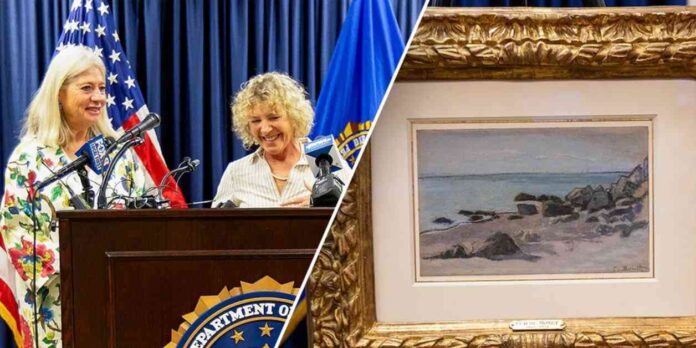An early work by Claude Monet, the impressionist master, was recently returned to the descendants of its rightful owner in New Orleans. The painting, titled “Bord de Mer,” dates back to 1865 and depicts a beach in Normandy near Le Havre called Sainte-Adresse, which was liberated during the D-Day invasion in 1944.
The descendants, Helen Lowe and Françoise Parlagi, along with Anne Webber, the co-chair of the Looted Art Commission in Europe, shared their exclusive interviews with Fox News Digital. The emotional and historical significance of the painting far surpasses its monetary value of up to $700,000, as it serves as a connection to the Parlagi family’s past and legacy that was nearly erased.
The painting was originally acquired by Adalbert “Bela” Parlagi in 1936 during an auction in Vienna, Austria. However, he and his wife, Hilda, had to flee Vienna in 1938 due to the Anschluss with Nazi Germany, leaving behind their belongings, including the Monet painting. The Nazis seized the property and put it up for sale in 1941 and 1942, denying Adalbert any compensation post-war.
After Adalbert’s death in 1981, his son, Franz, continued his quest to recover the lost artworks but unfortunately passed away in 2012 without success. It wasn’t until 2014 that Lowe and Françoise Parlagi approached the Looted Art Commission in Europe to track down the Monet piece, leading to detailed research and collaboration with the FBI’s Art Crime Team in 2021.
The FBI found the Monet painting in the possession of the Schlamp family in New Orleans, who voluntarily surrendered the piece upon learning of its true provenance. A court ruling in May 2024 confirmed the painting’s rightful ownership by Lowe and Françoise Parlagi, with power of attorney granted to Anne Webber.
On October 9, 2024, a symbolic meeting took place at the FBI New Orleans field office, where the painting was officially repatriated to the Parlagi family. Special Agent in Charge Lyonel Myrthil expressed gratitude for the Schlamp family’s cooperation in righting the wrongs of the past, emphasizing the importance of public and art community support in resolving similar cases in the future.
Despite the successful restitution of the Monet painting, Anne Webber stressed the ongoing importance of recognizing and recovering lost cultural treasures from World War II. She highlighted the significance of upholding conventions on human rights and property ownership to prevent such crimes against humanity from occurring again.
In conclusion, the journey of returning the Monet painting to its rightful heirs serves as a poignant reminder of the lasting impact of war and the importance of preserving cultural heritage for future generations.






















